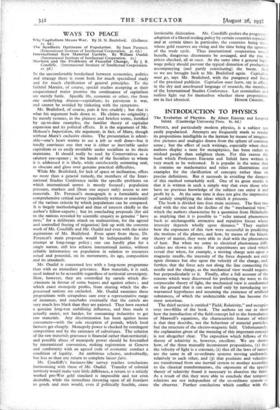INTRODUCTION TO PHYSICS
The Evolution of Physics. By Albert Einstein and Leopold Infeld. (Cambridge University Press. 8s. 6d.)
PHYSICS, and particularly modern physics, .is a subject not easily popularised. Attempts are frequently made to render its propositions intelligible to the layman by means of imagina- tive pictures and analogies drawn from the sphere of common sense ; but the effect of such writings, especially when their authors display a taste for metaphysics, has been rather to mislead people than enlighten them. For this reason the book which Professors Einstein and Infeld have written is very much to be welcomed. It is popular in the sense that it contains no mathematics and relies on illustrations and examples for the clarification of concepts rather than on precise definitions. But it succeeds in avoiding the dangers of this method remarkably well. One of its great merits is that it is written in such a simple way that even those who have no previous knowledge of the subject can enjoy it and profit by it. At the same time it does not give the.impression of unduly simplifying the ideas which it presents.
The book is divided into four main sections. The first two deal with the rise and the decline of the "mechanical view," which the authors characterise by a quotation from Helmholtz as implying that it is possible to " refer natural phenomena back to unchangeable attractive and repulsive forces whose intensity depends wholly upon distance." They explain how the exponents of this view were successful in predicting the motions of the planets, and how, by means of the kinetic theory of matter, they were able to deal with the phenomena of heat. But when we come to electrical phenomena diffi- culties are shown to arise. For experiments are cited which reveal that when, for example, a moving charge acts, upon a magnetic needle, the intensity of the force -depends not only upon distance but also upon the velocity of the charge, and, further, that the force acts not along the line connecting the needle and the charge, as the mechanical view would require, but perpendicularly to It. Finally, after a full account of the reasons which were discovered for preferring the wave to the corpuscular theory of light, the mechanical view is condemned on the ground that it can save itself only by introducing un- warranted hypotheses and assuming the existence of artificial substances, of which the undetectable ether has become the most notorious.
The third section is entitled" Field, Relativity," and occupies over two-fifths of the book. The authors set out to show how the introduction of the field-concept led to the formulation of Maxwell's equations, the characteristic feature of which is that they describe, not the behaviour of material particles, but the structure of the electro-magnetic field. Unfortunately, the explanation given of the meaning of this important concept is not altogether clear. The exposition which follows of the theory of relativity is, however, excellent. We are shown how, of the three mutually inconsistent propositions, (1) that the velocity of light is a constant, (2) that all the laws of nature are the same in all co-ordinate systems moving uniformly, relatively to each other, and (3) that positions and velocities are transformed from one inertial system to another according to the classical transfcirmations, the exponents of the special theory of relativity found it necessary to abandon the third As a result of this they were able to conclude that temporal relations are not independent of the co-ordinate system of the observer. Further conclusions which conflict with the ideas of classical mechanics are that the law that force is simply proportional to change of velocity is valid only for small velocities, and that there is no essential distinction between energy and mass. The validity of the special theory of rela- tivity is confined to inertial co-ordinate systems, but in the general theory this restriction is removed. Consequently, one has to abandon the use of Euclidean geometry, which cannot conveniently be applied to all co-ordinate systems. The authors add to their description of the theory a brief account of some ways in which it has been experimentally verified.
The final section on Quanta is short and summary. There is, surprisingly, no discussion of the principle of indeter- minacy, nor is it made very clear why in dealing with quanta we have to be content with statistical laws. But a good general account is given of the nature and the experimental basis of



































 Previous page
Previous page